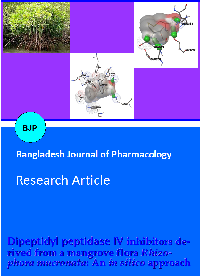Dipeptidyl peptidase IV inhibitors derived from a mangrove flora Rhizophora mucronata: An in silico approach
DOI:
https://doi.org/10.3329/bjp.v7i3.11636Keywords:
AutoDock, Diabetes, Human apo DPP-4 protein, MangroveAbstract
Dipeptidyl peptidase IV (DPP IV) is responsible for conversion of glucose tolerance (GLP-1), into inactive form. The inhibition of DPP IV would be beneficial in the treatment of diabetes mellitus. Therefore, the aim of the present study was to isolate and evaluate cystine, phenyl acetic acid, acrylamide, caprylone and oleic acid from Rhizophora mucronata inhibitory action on DPP IV inhibitors using in silico approach. In silico analysis of cystine, phenyl acetic acid, acrylamide, caprylone and oleic acid on human apo DPP IV protein was done by using Autodoc 4.0. Among the five compounds cysteine acts as an inhibitor with binding energy -5.89 kcal/mol, seven hydrogen bond interactions at residues VAL459, VAL 459, GLU408, GLU206, ARG358, GLU205 and SER209 to suppresses the action of DPP IV protein.
Downloads
676
562 Read
27
References
Abbott CA, Yu DMT, Woollatt E, Sutherland GR, McCaughan GW, Gorrell MD. Cloning, expression and chromosomal localization of a novel human dipeptidyl peptidase (DPP) IV homolog, DPP8. Eur J Biochem. 2000; 67: 6140-50.
Balajee R, Dhanarajan MS. Identification and comparative molecular Docking analysis of 6, 7, 8, 9-tetrahydro-2H-11-oxa-2, 4, 10-triaza-benzo[B] fluoren-1-one (RBMS-01) bounds with DPP4 for anti-hyperglycemic activities. Chem Sci Transc. 2012; 1: 279-88.
Bandaranayake WM. Economic, traditional and medicinal uses of mangroves. Australian Institute of Marine Science, Townsville, Australia, 1999, p 82.
Bnouham M, Ziyyat A, Mekhfi H, Tahri A, Legssyer A. Medicinal plants with potential antidiabetic activity: A review of ten years of herbal medicine research. Int J Diabetes Metab. 2006; 14: 1-25.
Borges BF, Jorge MR, Morgan CM, Da Silveria DX, Custodio O. Binge-eating disorder in Brazilian women on a weight-loss program. Obesity Res. 2002; 10: 1127-34.
Breda A, Basso LA, Santos DS, De Azevedo JR. Virtual screening of drugs: Score functions, docking and drug design. Curr Comput Aided Drug Des. 2008; 4: 265-72.
Fredenrich A, Palle S, Canivet B. Dipeptidyl peptidase inhibitors: A new step towards normoglycemia. Open Endocrinol J. 2009; 3: 16-21.
Gurudeeban S, Ramanathan T. Antidiabetic effect of Citrullus colocynthis in alloxan-induced diabetic rats. Inventi Rapid Ethnopharmacol. 2010; 1: 112.
Gurudeeban S, Satyavani K, Ramanathan T, Balasubramanian T. Antidiabetic effect of a black mangrove species Aegiceras corniculatum in alloxan-induced diabetic rats. J Adv Pharm Technol Res. 2012; 3: 52-56.
Gurudeeban S, Satyavani K, Ramanathan T. Alpha glucosi-dase inhibitory effect and enzyme kinetics of coastal medicinal plants. Bangladesh J Pharmacol. 2012; 7: 186-91.
Khodade P, Prabhu R, Chandra N, Raha S, Govindarajan R. Parallel implementation of AutoDock. J Applied Crystallogr. 2007; 40: 598-99.
Kiel S, Bruss M, Bonisch H, Gothert M. Pharmacological properties of the naturally occurring Phe-124-Cys variant of the human 5-HT1B receptor: changes in ligand binding, G-protein coupling and second messenger formation. Pharmacogenetics. 2000; 10:655-66.
Mest HJ, Mentlein R. Dipeptidyl peptidase inhibitors as new drugs for the treatment of type 2 diabetes. Diabetologia 2005; 48: 616-20.
Morris GM, Goodsell DS, Halliday RS, Huey R, Hart WE, Belew RK, Olson AJ. Automated docking using a Lamarckian genetic algorithm and an empirical binding free energy function. J Comput Chem. 1998; 19: 1639-62.
Ramanathan T, Hariharan B, Ganesan K. Antidiabetic activity of a coastal mangrove leaves of Rhizophora mucronata. Int. J Plant Res: Plant Arch. 2008; 8: 931-33.
Rohini RM, Das AK. A comparative evaluation of an analgesic and anti-inflammatory activities of I Rhizophora mucronata bark extracts. Pharmacology Online. 2009; 1: 780-91.
Sakashita H, Akahoshi F, Yoshida T, Kitajima H, Hayashi Y, Ishii S, Takashina Y, Tsutsumiuchi R, Ono S. Lead optimization of [(S)-gamma-(arylamino)prolyl]thiazolidine focused on gamma-substituent: indoline compounds as potent DPP-IV inhibitors. Bioorg Med Chem. 2007; 15: 64155.
Sunil Kumar, Vipin Kumar, Monika Rana, Dinesh Kumar. Enzymes Inhibitors from plants: An alternate approach to treat diabetes. Pharmaco Commun. 2012; 2: 18-33.
Weast Rt C (ed). CRC handbook of chemistry and physics. 62nd ed. Boca Raton, FL, CRC Press, 1981, p C-259.
Weber AE. Dipeptidyl peptidase IV inhibitors for the treatment of diabetes. J Med Chem. 2004; 47: 4135-41.
Zhang S, Kumar K, Jiang X, Wallqvist A, Reifman J. DOVIS: An implementation for high-throughput virtual screening using AutoDock. BMC Bioinform. 2008; 9: 126.

Published
How to Cite
Issue
Section
License
Authors who publish with this journal agree to the following terms:
- Authors retain copyright and grant the journal right of first publication with the work simultaneously licensed under a Creative Commons Attribution License that allows others to share the work with an acknowledgement of the work's authorship and initial publication in this journal.
- Authors are able to enter into separate, additional contractual arrangements for the non-exclusive distribution of the journal's published version of the work (e.g., post it to an institutional repository or publish it in a book), with an acknowledgement of its initial publication in this journal.
- Authors are permitted and encouraged to post their work online (e.g., in institutional repositories or on their website) prior to and during the submission process, as it can lead to productive exchanges, as well as earlier and greater citation of published work (See The Effect of Open Access).
